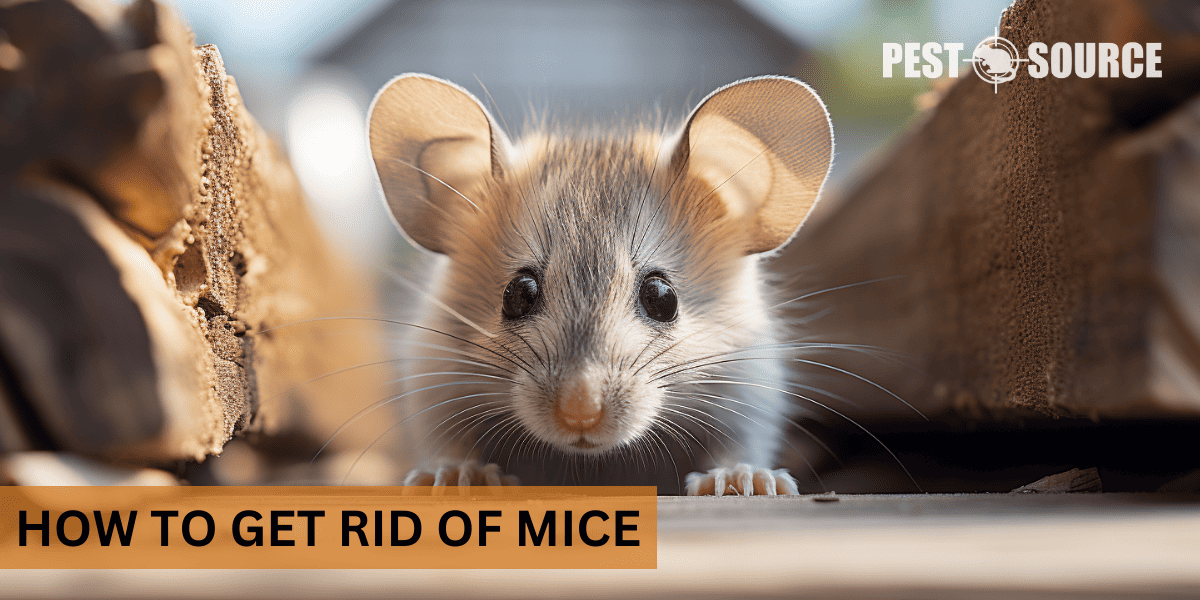This guide to mouse control offers 19 effective methods to get rid of mice. It includes practical methods like snap, electric, and glue traps, humane options like live catch traps, natural deterrents such as peppermint oil and cayenne pepper, and preventive strategies like adopting cats. For severe cases, we also discuss the option of professional extermination.
1. Use Snap Traps
Snap traps are a time-tested method for effectively killing mice. These traps use a snapping mechanism that quickly eliminates the rodent upon triggering. They are best placed along walls or near areas of high mouse activity. Snap traps are reusable and can be baited with foods like peanut butter. It’s important to regularly check and reset these traps, and to use caution in homes with children or pets to avoid accidental injuries.
2. Employ Electric Traps
Electric traps offer a modern solution to control mice infestations. These traps lure mice inside with bait and then deliver a lethal electric shock. Electric traps are known for their cleanliness and ease of disposal, as they often come with a chamber for containing the mouse. They are suitable for indoor use and are a more discreet option compared to traditional traps. Regularly check and clean these traps to maintain their effectiveness.
3. Apply Glue Traps
Glue traps are a simple, yet effective way to catch mice. These traps consist of a sticky adhesive surface that captures mice upon contact. They are easy to set up and can be placed in areas where mice activity is noticed. While glue traps for mice are non-toxic and safe around children and pets, they do not kill the mouse, which may raise humanitarian concerns. Regular monitoring of these traps is essential to deal with captured mice humanely.
4. Set Up Live Catch Humane Traps
Live catch humane traps are ideal for those who prefer a non-lethal method to manage mice problems. These humane traps catch a mouse without killing it, allowing for their release in a distant outdoor location. They work by luring mice into a container from which they cannot escape. Regular inspection of these traps is vital to ensure that any captured mice are released promptly to prevent stress and harm.
5. Establish Bait Stations
Bait stations are an effective way to control mice populations using poison in a contained environment. These stations house rodenticide and allow mice to enter and feed on the bait. Bait stations for mice are designed to be tamper-resistant, making them safer around children and pets. It’s important to place them in strategic locations where mice are active and to regularly check and replenish the bait. Caution should be exercised in handling and disposing of dead mice, as the poison can be harmful to other wildlife and pets.
6. Distribute Poison Pellets
Poison pellets are a potent method for eliminating mice. These pellets contain rodenticides that mice consume and subsequently perish. When using poison pellets, it’s crucial to place them in areas frequented by mice yet out of reach of children and pets. These pellets work over a few days, so patience is necessary. Additionally, one should be cautious of the potential risks to wildlife and pets and properly dispose of deceased mice to prevent secondary poisoning.
7. Implement Bucket Traps
Bucket traps are an ingenious and cost-effective way to catch multiple mice. These traps involve a bucket filled with water and a ramp leading to the top, where bait is placed on a platform. Mice, attracted by the bait, fall into the bucket and cannot escape. This method can be made humane by not filling the bucket with water, thus trapping the mice alive for relocation. It’s important to check these traps regularly to ensure humane treatment of the trapped mice.
8. Activate Ultrasonic Repellent
Ultrasonic repellents are a non-invasive way to deter mice. These devices emit high-frequency sound waves that are uncomfortable for mice but inaudible to humans and most pets. They are ideal for those who prefer a non-lethal and chemical-free method. Ultrasonic repellents for mice are easy to use, simply plug them into an electrical outlet in areas where mice are a problem. Keep in mind, their effectiveness can vary, and they may need to be used in combination with other methods for best results.
9. Sprinkle Crushed Red Pepper
Using crushed red pepper is a natural and humane way to deter mice. The strong scent and taste of the pepper act as a repellent. Sprinkle it in areas where mice are prevalent, such as near entry points and along walls. This method is safe for use around children and pets and can be a part of an eco-friendly pest control strategy. Regular reapplication of the pepper is necessary, as its effectiveness can diminish over time or in outdoor areas where weather can wash it away.
10. Scatter Cayenne Pepper
Cayenne pepper is another natural deterrent for mice. Its pungent smell and spicy taste repel mice effectively. Scatter the pepper in areas of mouse activity, especially in corners, near entry points, and along paths where mice travel. Cayenne pepper is non-toxic and safe to use around the house but may need regular reapplication, especially in areas exposed to the elements or where the scent can dissipate quickly.
11. Diffuse Peppermint Oil
Peppermint oil is known for its strong aroma, which mice find unpleasant. Diffusing peppermint oil or placing cotton balls soaked in the oil near suspected entry points can help keep mice away. This method is natural and safe for use in homes. However, it requires frequent reapplication to maintain its effectiveness, and the oil should be kept away from pets, as it can be harmful to them.
12. Apply Vinegar
Vinegar, with its strong scent, can act as a deterrent for mice. Wipe surfaces or spray areas with a mixture of vinegar and water where mice are present. This vinegar method not only helps to keep mice at bay but also cleans and disinfects the surfaces. Regular application is necessary as the smell of vinegar fades over time.
13. Spread Salt
Salt can be used as a barrier to prevent mice from entering certain areas. Sprinkling salt around entry points and along the walls can help deter them. While salt is a more passive deterrent and might not be as effective as other methods, it’s a safe and non-toxic option for homes.
14. Use Baking Soda
Baking soda can be used as a homemade rodenticide. Mixing baking soda with a bait such as peanut butter can be effective, as ingesting baking soda is lethal for mice. This method should be used cautiously, especially around pets and children, as it can be harmful if ingested.
15. Place Cloves
Cloves or clove oil can serve as a natural mouse repellent. The strong scent of cloves is disliked by mice. Place whole cloves or cotton balls soaked in clove oil in areas where mice activity is noted. This method is safe and natural but requires regular replacement of cloves to maintain effectiveness.
16. Dispense Cinnamon
Cinnamon is another spice that can repel mice with its strong aroma. Sprinkle cinnamon powder or place cinnamon sticks in areas frequented by mice. This method is safe for use in homes, and besides deterring mice, it leaves a pleasant scent. However, it requires frequent application for sustained effectiveness.
17. Employ Mothballs
Mothballs can deter mice due to their strong odor. Place them in areas where mice are a problem, such as attics, basements, or garages. Caution should be exercised when using mothballs for mice, as they contain chemicals that can be harmful to humans and pets if ingested or inhaled over long periods.
18. Adopt Cats
Cats are natural predators of mice and can be an effective and eco-friendly way to control a mouse population. The presence of a cat in your home can deter mice. Besides, cats can eat mice and actively hunt them to reduce the number of mice. Ensure the cat is well-cared for and consider its temperament and compatibility with your living situation.
19. Contact an Exterminator
When all else fails, or the mouse infestation is severe, contacting a professional exterminator is advisable. Exterminators have the knowledge, experience, and tools to effectively eliminate mouse problems. The cost to hire an exterminator for mice is well worth it as they can also provide advice on preventing future infestations and identify potential entry points that need to be sealed.
How to Effectively Get Rid of Mice in Specific Areas?
Understanding how to effectively get rid of mice in specific areas is crucial, as these pests can infiltrate various parts of a home or other structures, each presenting unique challenges. Whether they’re scurrying within walls, nesting in the quiet corners of an attic, or finding refuge in your garage, kitchen cabinets, or even vehicles like cars and campers, effective mouse control requires targeted strategies.
How to Get Rid of Mice in Walls
Mice in walls are a common issue. To get rid of mice in walls, identify and seal entry points such as cracks or holes. Use traps near these areas, as mice often exit walls for food. For more insights, explore our detailed guide on eradicating mice from walls.
How to Get Rid of Mice in Apartment
Dealing with mice in an apartment involves cleanliness, sealing entry points, and using traps or repellents. Since apartments have shared walls, coordination with neighbors and landlords is key. Discover more in our comprehensive article on apartment mouse control.
How to Get Rid of Mice in Attic
Attics offer ideal nesting spots for mice. Clear out clutter, seal gaps, and set traps or bait stations. Insulation may need inspection for nests. Learn more about effective attic mouse eradication methods in our focused guide.
How to Get Rid of Mice in Garage
Mice find garages appealing due to clutter and occasional quiet. Remove clutter, seal entry points, and use traps. Consider repellents for ongoing prevention. Our article provides a step-by-step approach to keeping your garage mouse-free.
How to Get Rid of Mice in Ceiling
Mice in ceilings can be addressed by sealing entry points and setting traps in the attic or along the walls. Noise and scent repellents can also be effective. For a detailed strategy, see our article on eliminating mice from ceilings.
How to Get Rid of Mice in Kitchen Cabinets
To eliminate mice in kitchen cabinets, keep food in sealed containers, use traps, and seal gaps. Cleanliness is crucial to deter these pests. Our guide offers tailored advice for dealing with mice in kitchen spaces.
How to Get Rid of Mice in Car
Mice can damage car wiring and insulation. Keep your car clean, park in well-lit areas, and use repellents. Traps can also be placed near the car. For more strategies, read our guide to keeping mice out of your car.
How to Get Rid of Mice in Camper
Campers are prone to mouse infestations during storage. Use repellents, seal entry points, and clean thoroughly before storage. For in-depth tactics to protect your camper from mice, check out our guide to keep mice out of a camper.
How to Mouse-Proof Your House
Preventing mice infestations is key to a pest-free home. This involves sealing entry points, maintaining cleanliness, and employing deterrents like peppermint oil or ultrasonic devices. Regular inspection of your home for signs of mice can help catch issues early and help mouse-proof your house.
How to Permanently Get Rid of Mice
Achieving a permanent solution to mouse problems requires a combination of immediate control methods and long-term preventive strategies. This includes using traps or baits effectively and addressing environmental factors that attract mice.



